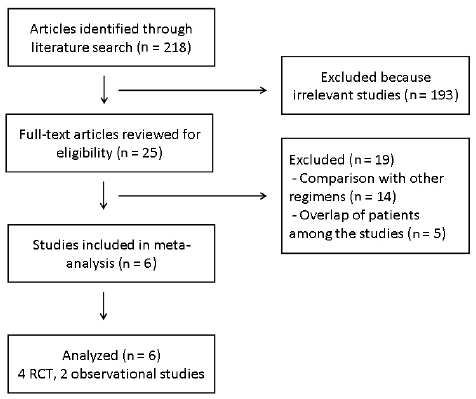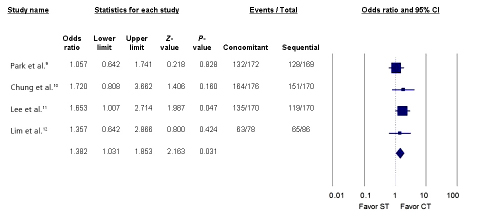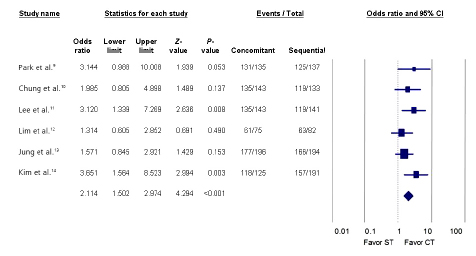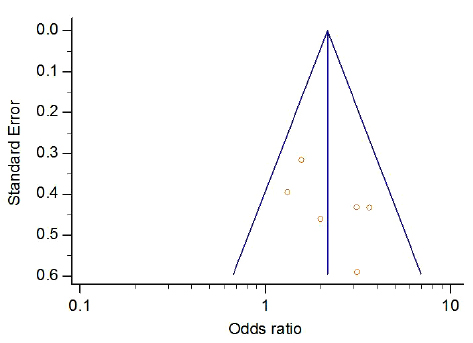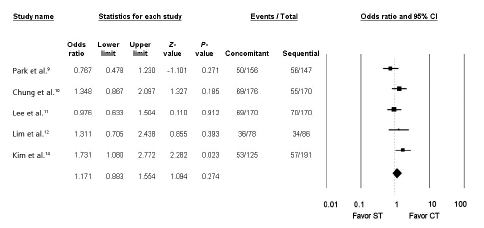Korean J Gastroenterol.
2018 Jan;71(1):31-37. 10.4166/kjg.2018.71.1.31.
Concomitant or Sequential Therapy as the First-line Therapy for Eradication of Helicobacter pylori Infection in Korea: A Systematic Review and Meta-analysis
- Affiliations
-
- 1Division of Gastroenterology, Department of Internal Medicine, Incheon St. Mary's Hospital, College of Medicine, The Catholic University of Korea, Incheon, Korea. gastro@catholic.ac.kr
- KMID: 2402803
- DOI: http://doi.org/10.4166/kjg.2018.71.1.31
Abstract
- BACKGROUND/AIMS
In Korea, increasing clarithromycin resistance has led to the need for an alternative first-line therapy for the eradication of Helicobacter pylori (H. pylori) infection. Concomitant therapy (CT) and sequential therapy (ST) have been proposed as alternative regimens. The aim of this study was to compare the eradication rate from using CT and ST in Korea.
METHODS
A literature review was performed on studies comparing the efficacy of CT and ST in Korea. Data were pooled to obtain the odds ratio (OR) of the eradication rate with 95% confidence intervals (CIs). The eradication rates were considered both on an intention-to-treat (ITT) and a per-protocol (PP) bases.
RESULTS
Six studies provided data on 1,897 Korean adult patients. The pooled OR was 1.382 (95% CI: 1.031-1.853, p=0.031) for ITT analysis and 2.114 (95% CI: 1.502-2.974, p < 0.001) for PP analysis. There was no difference in the rate of adverse events and compliances between the two regimens.
CONCLUSIONS
The efficacy of CT was superior to ST in both ITT and PP analyses. Therefore, CT could be an excellent alternative regimen for the eradication of H. pylori as a first-line therapy in Korea.
Figure
Cited by 1 articles
-
New Helicobacter pylori Eradication Therapies
Jae Yong Park, Jae Gyu Kim
Korean J Gastroenterol. 2018;72(5):237-244. doi: 10.4166/kjg.2018.72.5.237.
Reference
-
1. Kim N, Kim JJ, Choe YH, et al. Diagnosis and treatment guidelines for Helicobacter pylori infection in Korea. Korean J Gastroenterol. 2009; 54:269–278.
Article2. Kim SG, Jung HK, Lee HL, et al. Guidelines for the diagnosis and treatment of Helicobacter pylori infection in Korea, 2013 revised edition. Korean J Gastroenterol. 2013; 62:3–26.
Article3. Papastergiou V, Georgopoulos SD, Karatapanis S. Current and future insights in H. pylori eradication regimens: the need of tailoring therapy. Curr Pharm Des. 2014; 20:4521–4532.
Article4. Kim YK, Kim JS, Kim BW. Recent trends of Helicobacter pylori eradication therapy in Korea. Korean J Helicobacter Up Gastrointest Res. 2012; 12:219–223.5. Kim JS, Park SM, Kim BW. Sequential or concomitant therapy for eradication of Helicobacter pylori infection: a systematic review and meta-analysis. J Gastroenterol Hepatol. 2015; 30:1338–1345.6. Liberati A, Altman DG, Tetzlaff J, et al. The PRISMA statement for reporting systematic reviews and meta-analyses of studies that evaluate health care interventions: explanation and elaboration. J Clin Epidemiol. 2009; 62:e1–e34.
Article7. Higgins JPT, Altman DG, Sterne JAC. Cochrnae handbook for systematic reviews of interventions, version 5.1.0. Chapter 8: assessing risk of bias in included studies. [Internet]. London: Cochrane Training;2006. 09. updated Mar 2011. cited 2016 Jan 31. Available from: http://handbook.cochrane.org/chapter_8/8_assessing_risk_of_bias_in_included_studies.htm.8. Stang A. Critical evaluation of the Newcastle-Ottawa scale for the assessment of the quality of nonrandomized studies in meta-analyses. Eur J Epidemiol. 2010; 25:603–605.
Article9. Park SM, Kim JS, Kim BW, Ji JS, Choi H. Randomized clinical trial comparing 10- or 14-day sequential therapy and 10- or 14-day concomitant therapy for the first line empirical treatment of Helicobacter pylori infection. J Gastroenterol Hepatol. 2017; 32:589–594.10. Chung JW, Han JP, Kim KO, et al. Ten-day empirical sequential or concomitant therapy is more effective than triple therapy for Helicobacter pylori eradication: a multicenter, prospective study. Dig Liver Dis. 2016; 48:888–892.
Article11. Lee HJ, Kim JI, Lee JS, et al. Concomitant therapy achieved the best eradication rate for Helicobacter pylori among various treatment strategies. World J Gastroenterol. 2015; 21:351–359.12. Lim JH, Lee DH, Choi C, et al. Clinical outcomes of two-week sequential and concomitant therapies for Helicobacter pylori eradication: a randomized pilot study. Helicobacter. 2013; 18:180–186.13. Jung SM, Cheung DY, Kim JI, Kim I, Seong H. Comparing the efficacy of concomitant therapy with sequential therapy as the first-line therapy of Helicobacter pylori eradication. Gastroenterol Res Pract. 2016; 2016:1293649.14. Kim SY, Park DK, Kwon KA, Kim KO, Kim YJ, Chung JW. Ten day concomitant therapy is superior to ten day sequential therapy for Helicobacter pylori eradication. Korean J Gastroenterol. 2014; 64:260–267.15. Lee JW, Kim N, Kim JM, et al. Prevalence of primary and secondary antimicrobial resistance of Helicobacter pylori in Korea from 2003 through 2012. Helicobacter. 2013; 18:206–214.16. Chey WD, Leontiadis GI, Howden CW, Moss SF. ACG clinical guideline: treatment of Helicobacter pylori infection. Am J Gastroenterol. 2017; 112:212–239.
Article17. Fock KM, Katelaris P, Sugano K, et al. Second Asia-Pacific consensus guidelines for Helicobacter pylori infection. J Gastroenterol Hepatol. 2009; 24:1587–1600.18. Wang Y, Zhao R, Wang B, et al. Sequential versus concomitant therapy for treatment of Helicobacter pylori infection: an updated systematic review and meta-analysis. Eur J Clin Pharmacol. 2018; 74:1–13.
Article19. Malfertheiner P, Megraud F, O'Morain CA, et al. Management of Helicobacter pylori infection-the Maastricht V/Florence consensus report. Gut. 2017; 66:6–30.
- Full Text Links
- Actions
-
Cited
- CITED
-
- Close
- Share
- Similar articles
-
- Recent Trends of Helicobacter pylori Eradication Therapy: Focusing on First Line Treatment
- First-line Helicobacter pylori Eradication with Standard Triple Therapy and Concomitant Therapy: A Retrospective Study
- Treatment of Helicobacter pylori Infection in Korea: A Systematic Review and Meta-analysis
- Helicobacter pylori Eradication Therapy in Korea
- Sequential Therapy for Helicobacter pylori Infection in Korea: Systematic Review and Meta-Analysis

